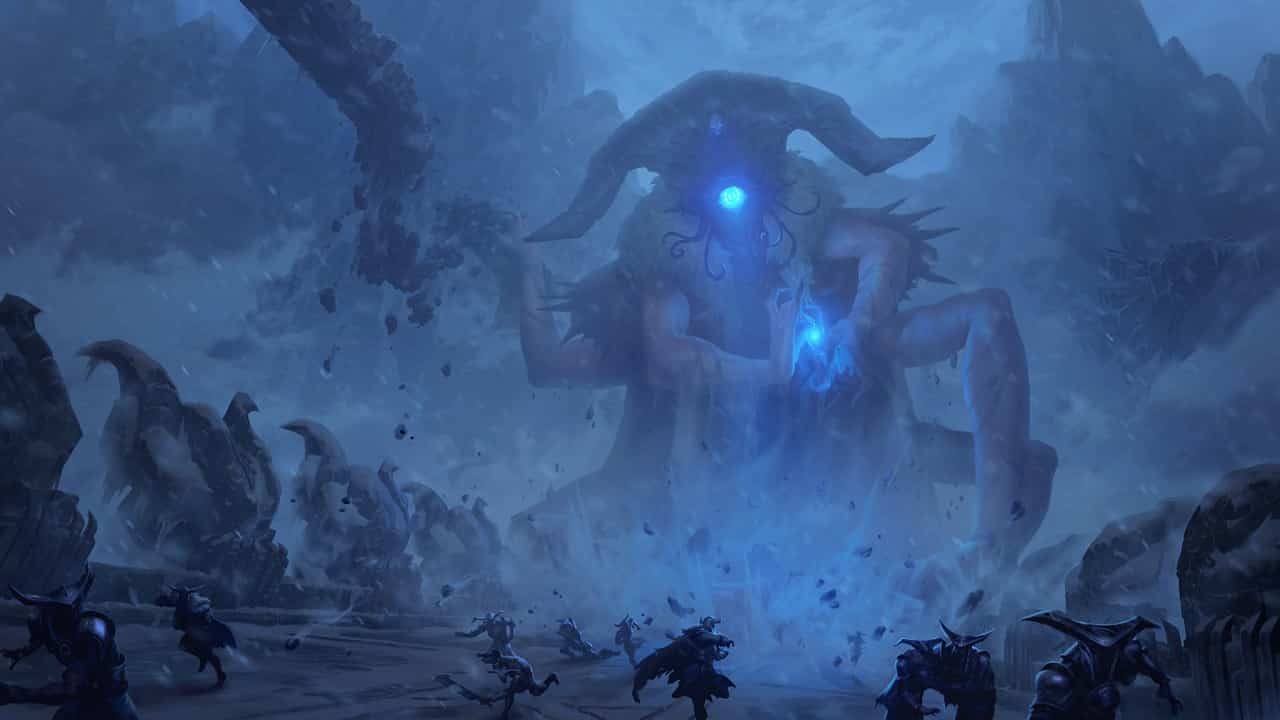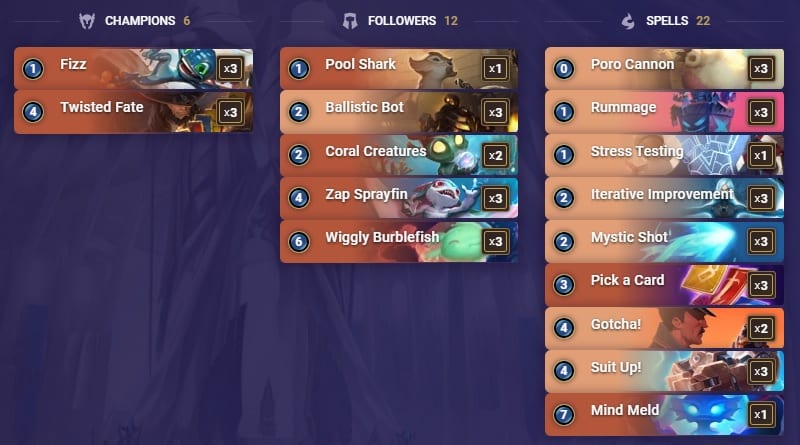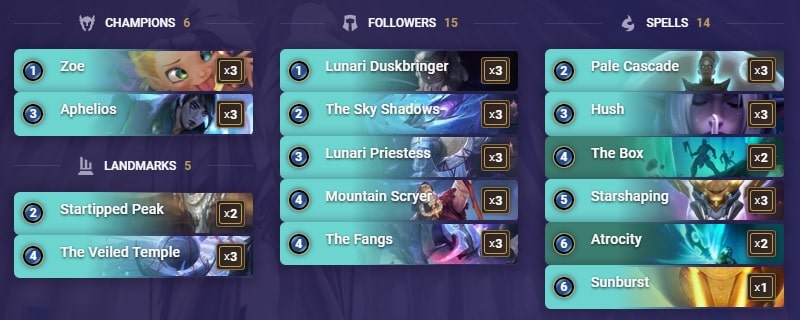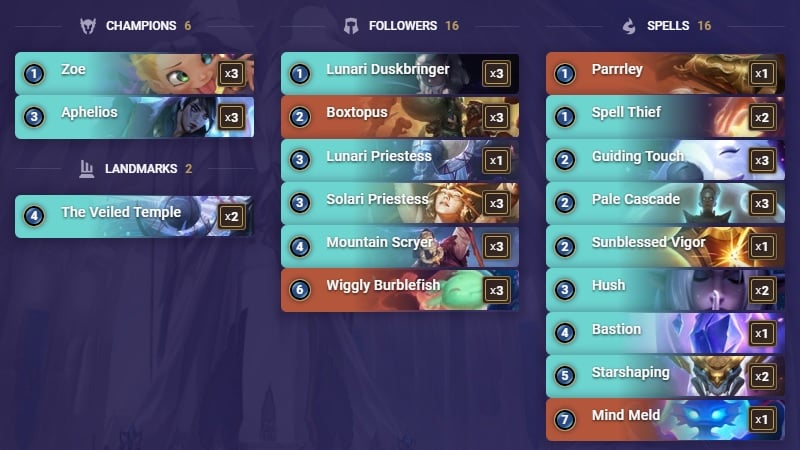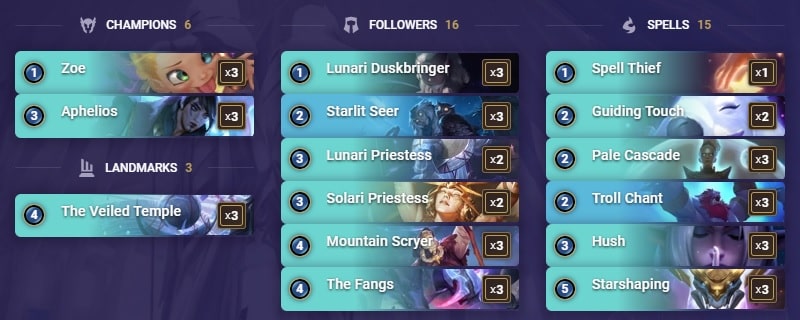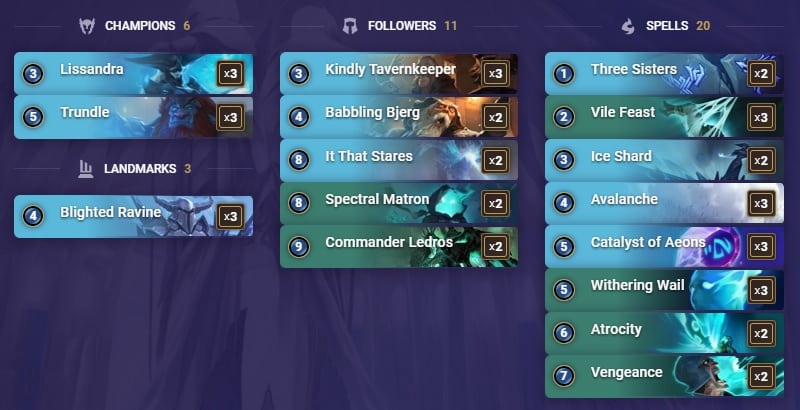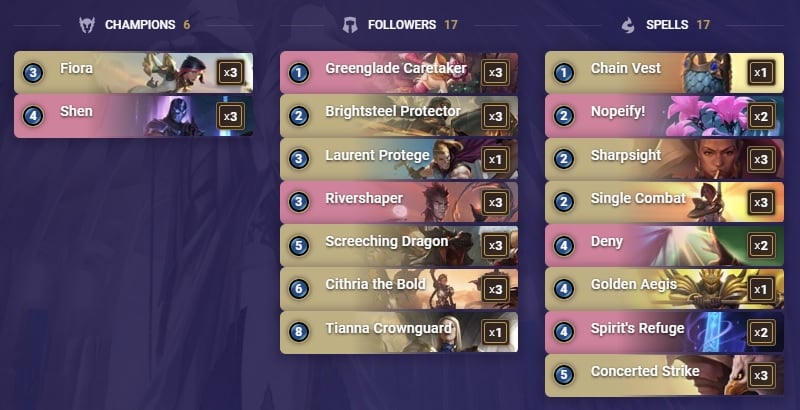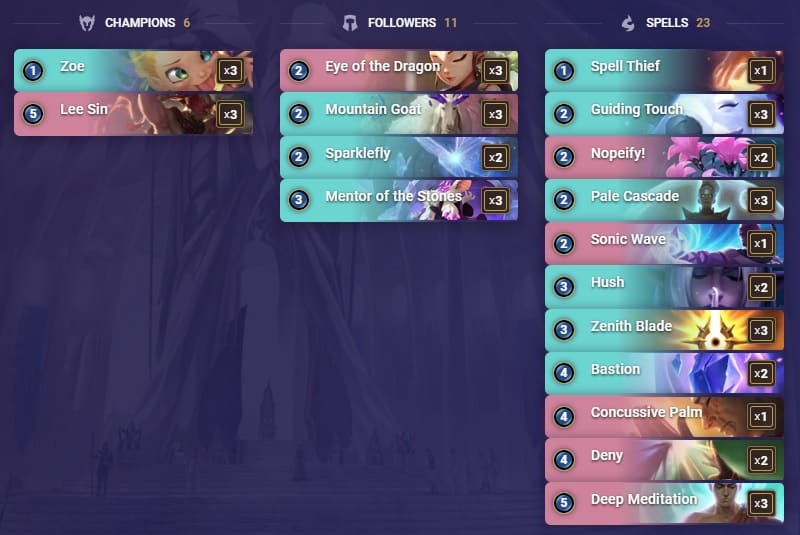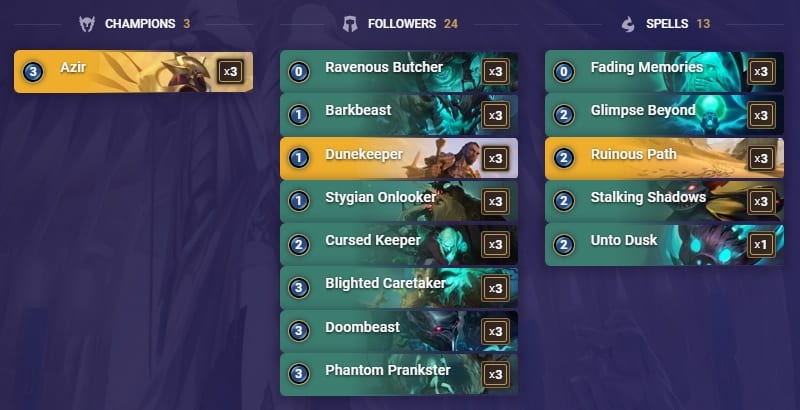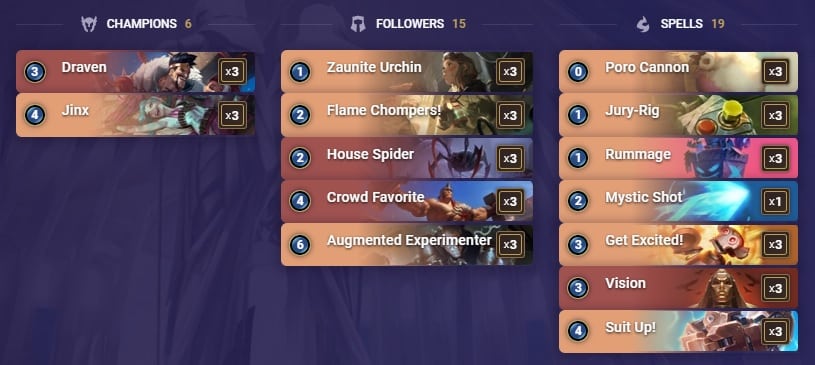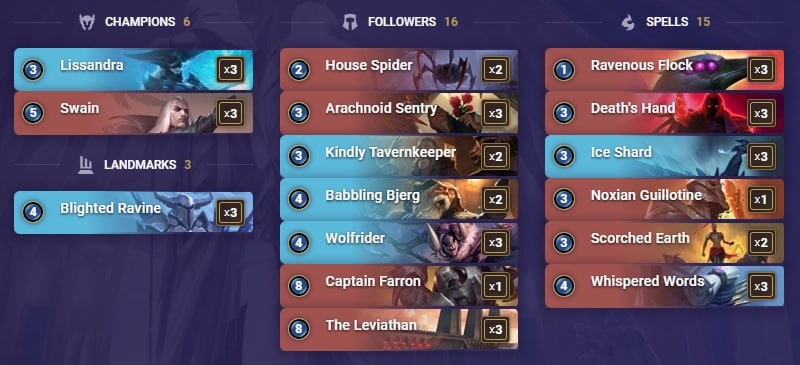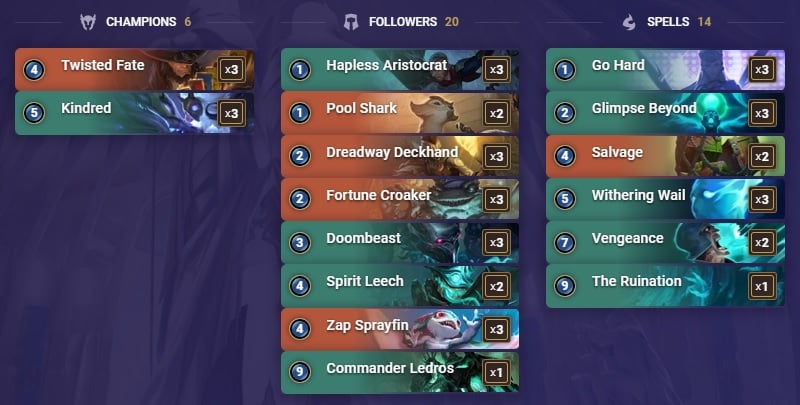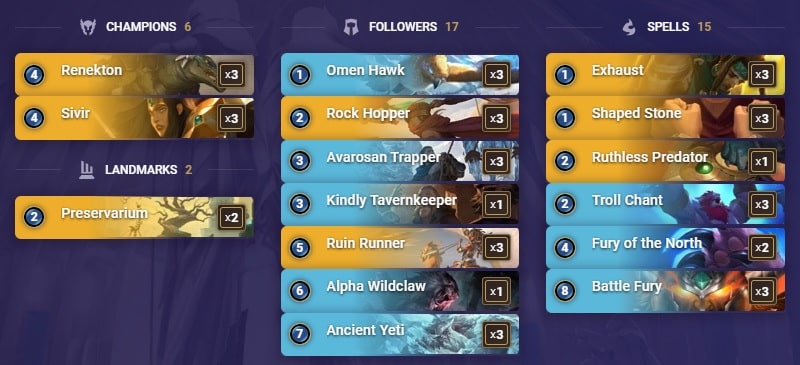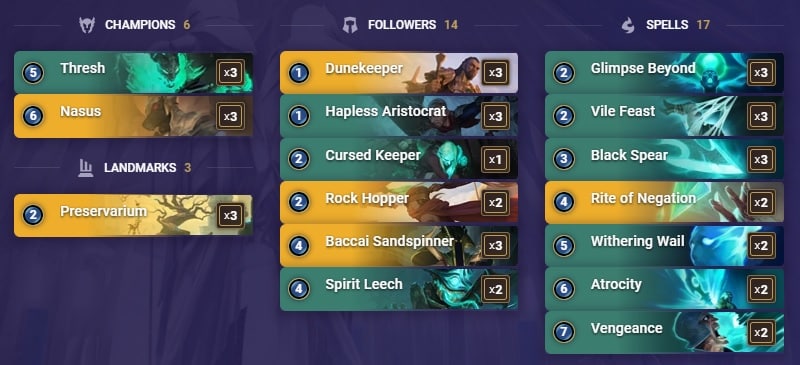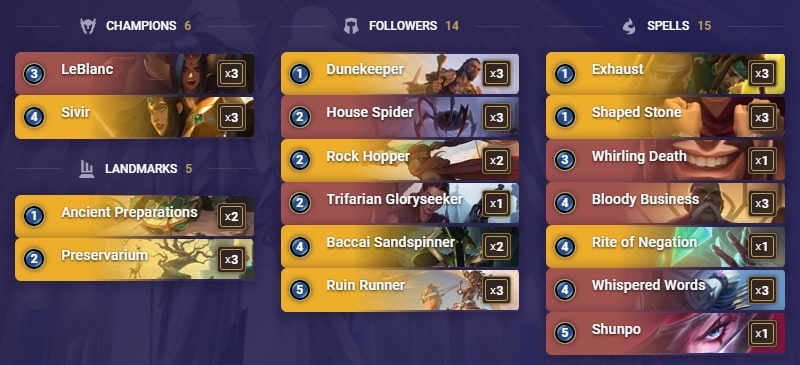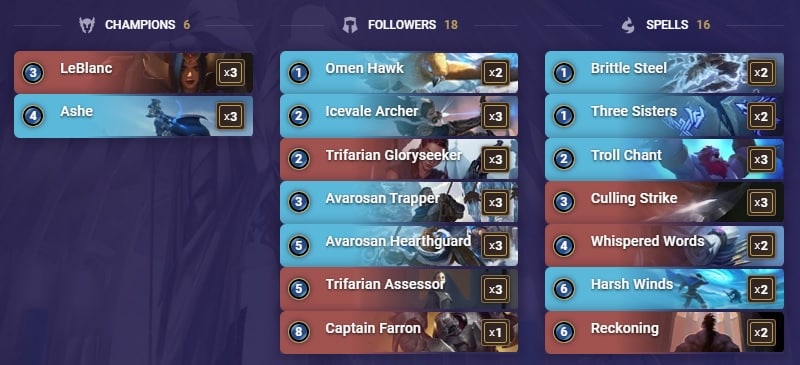Welcome to TLG’s latest meta snapshot for Legends of Runeterra, a series in which we give you our insight on the finest decks in the higher ranks of the ladder.
Every Monday, we discuss the decks that are part of the week’s meta and rate them on a scale of 1 to 5 stars. We also look at the evolution of said decks’ ratings across weeks and draw conclusions regarding the current state of the game, all of this so you can delve into your own ranked journey with a head start.
Now that the dust has started to settle after the expansion, we can bring you a more definitive list of decks and a decent analysis of them. For the most part, the decks that were strong before the expansion have remained at the top, the most prominent of which is (of course) Fizz-TF.
However, we’re still in the early stages of the meta development, so new contenders may be waiting in the wings for their time to shine. For example, Lissandra-Trundle, is already making a name for itself. With some balance changes, we might end up with a fresher situation in a couple of weeks.
If you have any questions, feel free to drop by our Discord. Best of luck on your climb!
Graphics: WellMax81
Editing: Wusubi, Sebodunum, Crixuz
Writers: Den, Ultraman, Othal

CICQCAQEAMAQGBQRAIAQIAJUAMBQIBINCICAEBQ2EYVS4AQBAIDA4AICAQDAEAIDAQMQEAQGBEVA
The first ever 5 stars in our snapshot had to go to the strongest deck in the history of the game. If I’d told you 2 months ago that Fizz would be part of the best deck we have ever seen, you’d have laughed at me. Yet, here we are. Fizz-TF is crazily unbalanced, being able to cheat the mana system, level-up TF in one turn, make an untargetable Fizz a big 4/4 and never run out of options thanks to the high amount of drawing abilities.
That being said, let’s review the possibilities we have to counter that annoying fish and the card dealer. The Box, Withering Wail, Ice Shard, Avalanche, Blighted Ravine and even Death Lotus! So many options to stop the fish from crushing your Nexus. Wait, what are you saying? Wiggly Burblefish cost nothing? While all the AoE costs mana?!
So they can force the removal out by pushing the boundaries with Fizz-TF as they level-up, the Ballistic Bot eroding your Nexus, then use the Burblefish to kill you in one turn, as you don’t have enough mana to defend yourself?
Well, forget everything I said prior. Play defensively, don’t ever use mana, and if you have to, pray to whatever you believe in that your opponent doesn’t have all of the Burblefish and ways to duplicate them. Slow spells won’t help you if the opponent knows how to play, fast spells can’t deal with the 4/2 Burblefish if you don’t have multiple copies of them.
Your opponent will be able to use up to 6 mana a turn while you’ll be stuck not using 8 to 10 of yours (if your deck even has the required answers). So how to beat Fizz-TF? Be patient and wait until the opponent makes a mistake that you can finally punish. If they don’t make mistakes, they’re going to win the game, and there’s nothing you can do about it. (Write-up by Ultraman)
Shadow Isles splash
CMAQWAYJBERUSS2MKRK5QAOZAHNQDXIBAIAQICIKAIAQKEYZAEAQGCIX
Bilgewater splash
CMBAEAYGA4IQOAYJBERTGSKMMDMQCAIEAMESUVCV3MAQEAQCAYJCUAYDBEJUWYQ
Freljord splash
CMBQCAIBEAAQGAICBEBQSCJDJFGFIVOZAHNQDXIBAEBQGCJTJNQACAIDBEVA
Aphelios is no longer paired with TF in most of the current builds, that distinction goes to Zoe now, forming what’s undoubtedly the most flexible champion pairing the game has to offer. Both champions are from the same region, and both are capable of carrying the game on their back with the absurd amount of value they can generate if they remain well-protected.
This makes Aphelios-Zoe one of the most feared duos on the ladder nowadays. While Fizz-TF is the best deck, Aphelios-Zoe can definitely brag about being the most flexible and unpredictable. The deck has access to a never-ending flow of Celestial cards, two early game champions forcing the opponent to react to them and a low curve which can still play 7-9 mana bombs in the late game. This archetype is the definition of an “all-around deck.”
Proof of this is the amount of splash possibilities we’re currently seeing, as Targon has been paired with SI, Bilgewater and even Frejlord to add the final 3 or 4 cards to the deck. SI looks to be the best combination for now, Atrocity being another card that could be in the discussion for a potential nerf.
It allows the deck to access direct damage to the enemy Nexus, one of the few things Targon isn’t capable of doing. Cards like The Box or Withering Wail can also help against Fizz-TF or Aggro decks for example, in case you wouldn’t feel like the healing capacity was enough.
When you see Bilgewater added to the deck, it’s due to Boxtopus, arguably the best 2-drop to get out of Aphelios’ Crescendum. The region also offers Mind Meld or Pick a Card if you would like to add a finisher or some more card draw to your deck.
While the Freljord splash might appear weaker than the other two, it has its merits. Starlit Seer is strong in this deck, as we’re playing spells each turn. If there’s The Veiled Temple in play, 3 spells will be more common than 1. Having Seer as the 2-drop helps the deck create beefy minions and fight the board much more efficiently.
This can help a ton against Midrange decks trying to beat us in combat. The addition of Troll Chant is another great tool with which to protect our champions or our health against Aggro decks.
For now, Aphelios-Zoe performs like the second best deck on our snapshot. It’s fascinating that Aphelios can perform that well despite being nerfed recently. It wouldn’t be shocking at all to see this deck rise to the very top if Fizz-TF is next up on the nerf hammer list. (Write-up by den)

CMCACAYBAYBACBI5FABAIAIFBYBQCAIMCQZAIAIBAEDQCAYBAMBAIAIJBICACBIBDEQSYAA
Lissandra offers a new win condition to the classic control SI/Freljord - Watcher, an enormous 17 mana card that will obliterate your opponent’s deck upon attack! Naturally, it has some stringent conditions to achieve before you can utilize it - you need to play an 8+ mana card 4 times in order to reduce its mana cost to 0.
Spectral Matron is a nice way to cheat out this card as an Ephemeral version, while also giving you two 8+ mana card summons. In this way, you can play Watcher with Matron as soon as it comes into our hand, while reducing the original one’s cost to zero! If your opponent is able to answer the first Watcher, how will they deal with the second one?
If the deck’s only weapon was 8+ mana monsters, you’d probably never reach that stage. Thankfully, the deck packs a myriad of AoE spells to ensure it has the ability to survive until then. Blighted Ravine, Avalanche, Ice Shard and Withering Wail will handle that pesky board until the big boys awaken and crush your opponent’s Nexus.
Add a bit of healing and an incredibly flexible card in Three Sisters and you’ve got yourself a decent mix that’ll be able to handle most of what is on show in the current meta. However, don’t forget that control Shadow Isles can easily be countered, as even if the list and win cons change, one thing, one thing never changes. War never... Actually, Ionia is pretty peaceful, but they can still Deny any attempt at playing the game that SI/Freljord might have! (Write-up by Ultraman)
CMCACAQAAEBAGAAGBYBQCAQTEAVQIAIABENC2MYCAEBQEFACAEBCKMICAECAAAQDAEAAECYN
In a brand new environment, being able to rely on evergreen concepts is a major help, and of course this is where Fiora-Shen comes in. Probably still the best pure tempo deck of our top 5, Fiora-Shen is one of the few decks that still aims at winning the game through combat instead of synergies on the back row.
The small difference now is that, with the arrival of Shurima and much more Vulnerable tags to go around, Shen looks to have grown in importance in the deck, as the Barriers are one of the best ways to prevent a unit from falling prey soon after gaining the Vulnerable tag.
While the deck didn’t receive a lot of help with the last expansion, one card has found its way into the deck, and it might be a difference-maker. Golden Aegis looks to be miles ahead of Relentless Pursuit in terms of flexibility, as the former can be used in a much wider variety of situations than the latter. One extra mana isn’t always something we want to pay for the card, but the added Barrier effect can be more than worth the investment.
It allows Fiora to be even scarier and creates more awkward situations for the opponent, who has to decide what takes the hit; the Nexus or a unit. Against control matchups, the card is great as we want to pressure as much as possible, so added attacks are always welcome. The Barrier keyword in this case helps mostly to level-up Shen, who’s the real star in the slower matchups. His +3/+0 bonus to allies with Barrier helps to push for significant Nexus damage.
The meta is much faster than before, so Brightsteel Formation is too slow to stay in the deck. Instead, our favorite angry lady is included: Tianna Crownguard. The deck functions the same way as before against most opponents. The multiple Rally effects are needed to pressure highly-synergistic decks like Lissandra-Trundle or Aphelios-Zoe, which you should encounter frequently.
Still a deck to account for in this new environment, Fiora-Shen looks to be a solid top 5 pick for now, although it still has a clear gap to cover to reach the top. Lovers of tempo gameplay and pressure strategies should find a reliable way to climb the ladder with this archetype, which, once again, has found a way to be relevant. (Write-up by den)
CMBAGAQCAMDASBQDBEERWIZJGNOAGAIBAIYQCAYCCQBQGCITFBKQEAIDBEVAEAQCAUEA
Lee Sin is another deck in our snapshot that hasn’t changed much with the Shurima expansion. After a quick digression with the Predict mechanic, the Blind Monk is back with his true ally: the Targon region. The Predict mechanic wasn’t so bad for the deck, as it allowed the archetype to be super reliable in what it tried to accomplish: a combo.
The problem was that the deck didn’t have any flexibility, which is extremely valuable in the current state of the game. As such, pairing Lee Sin with Targon appears to make him more versatile. The addition of Lissandra-Trundle to the meta aids this deck, as Lee Sin feasts on slower strategies that let him set up properly onto the board.
As time goes by and Aggro strategies are shown to not be working so well (at least at the highest level), Zoe-Lee appears to be one of the decks that got better with the Shurima expansion. While Fizz-TF admittedly destroys this deck most of the time with aggression that is too much to handle, the other archetypes give you a bit more room to work with.
Currently, a lot of the other Targon lists are running three copies of Hush, which hurts this deck a lot. Moreover, in overall terms, it seems that Aphelios-Zoe is superior to Zoe-Lee. It doesn’t mean that Lee isn’t a true contender in the current meta, though. What’s more, it could be a great tournament pick, if a control-heavy environment is to be expected. (Write-up by den)

CMCAEAQFAQDAGAYFAMCAMAYEA4BRUUQFAECQWJRPGAYQAAIBAQCQW
Every meta has a damage-based deck that punishes anyone who forgets to play in the early game. In the Shurima patch, that deck is Azir Burn. With a straightforward game plan and a Slay-based explosive start, it’s capable of dealing a ton of damage very early before attempting to finish off with direct damage.
However, the deck isn’t just a one-trick pony. It excels at punishing decks that would leave it alone and it’s great at keeping a high damage flow for a long period of time, making significant healing the only reliable option against it.
The small units in the deck are what make it flexible, as they deal damage early and later on help blocking the opponent while we drain their Nexus with Doombeast, Phantom Prankster and the many cards we have to support them. Crucially, these two cards will help deal direct damage even if the board is lost and our attack turns are worthless.
Given the high amount of draw the deck is packing, trying to outlast it like most decks attempt to do against Aggro strategies isn’t the best way to go about it. While the deck should lose some potential over time, it’s already facing erosion in the meta due to the increasing prevalence of healing (e.g. Aphelios decks, Fiora-Shen and Lissandra-Trundle all have some form of it).
Tier 2 decks can still be pounced on and outpaced as more board-centric decks should give us enough time to set up enough damage to close out the game before they can kill us with their units. The gameplay of this archetype might take a little bit of time to grasp, as the general concept isn’t to deal as much damage as possible, but try to put your opponent to 0.
This is more subtle a nuance than it might appear. If you go for the maximum damage output each turn, you also become very predictable for your opponent, who can focus on solely defending and wait for you to draw until they can be more aggressive. Instead, try to keep a regular damage flow and go for the kill when you’re sure it will actually result in a win.
That patience aspect is what makes the deck really scary, as the opponent will usually assume a defensive stance against you, giving you the time you need to set up properly and plan ahead for even more potential damage. Once you have this mastered, you’re ready to be a real terror on the ladder. (Write-up by den)
CMCACAQEAMAQGBASAQAQGCIUE43QOAIEAEGA2HBHFAWQAAIBAECDI
Similarly to Fiora-Shen, Discard Aggro is a deck that doesn’t change much from one meta to another, but then again, it doesn’t really need to. I consider this deck to be the gatekeeper of good decks in the current format. If you can’t handle Discard Aggro properly, you probably won’t have a good time against the other decks.
While the deck is capable of some insane high-rolls and could OTK someone on Turn 4, it’s also fairly predictable if you have the tools to deal with it. Although the deck has stayed basically the same, the meta being centered around slow decks helps it a lot.
Amazingly, I managed to maintain a positive winrate vs Lissandra-Trundle on my way to Masters with the deck, showing that even this control-packed deck more often than not didn’t have the answers to counter a heavy dose of early game aggression.
Suit up! is also a decent card to play around AoE and a leveled Jinx is a pain to remove for a lot of decks at the moment, so she’s free to generate a ton of value with her Super Mega Death Rockets turn after turn. I personally think the archetype still deserves the title of the best aggressive deck in the game, and its capacity to flood the board and present different levels of threats has to be respected. However, the aggressive decks as a whole aren’t looking so good right now.
Even if on paper, the top 5 decks should almost only be favorable matchups (although Fiora-Shen is incredibly hard to beat), the capacity of these decks to generate cards and get out of situations through healing or sheer value is incredible. As such, Discard Aggro feels like a really good deck, but one that can’t really consistently keep up with the big boys. Having no new cards to feed into the deck adds to this feeling.
Still a solid pick to climb the ladder, Discard Aggro can be regarded as a “quantity first” deck, whereas the best decks on our snapshot opt for the “quality” approach. It sounds like good news that the aggressive decks aren’t out of the picture though, and if decks keep on trying to be greedy, Discard Aggro could get even better matchups with time. (Write-up by den)
CMCQCAIDFYAQEAIJAECAGAQDAQAQKCIOAQBAGAIHBAEQGAIBAM3QCAYDBUBACAIHGIAQEAIDCYZQ
Swain’s back, and he has found a new and improved ally in Lissandra, who can give him access to an excellent stun and some damage on her level-up.
On top of this, the fact that she has a decent statline and a potential to eventually spawn an 8/8 with Overwhelm makes her an excellent partner for Swain. Multiple AoE spells help with Swain’s level-up, which he obtains easily by Turn 5 almost every game, rapidly pressuring the opponent while also handling aggression in the early turns.
Ice Shard and Blighted Ravine give your leveled-up Swain free stuns by hitting the opponent’s Nexus at the start of the turn, forcing the opponent into either having a removal spell or a 3+ strength unit with more than 2 health on the board in order to stop the mighty strategist from hitting their Nexus too hard.
Clearly, we are fans of The Leviathan card - its synergy with Swain is almost a game over message for your opponent, and the multiple draws of the deck makes it virtually certain to find your war ships each and every game.
Finally, something that’s a Noxian tradition at this point: if the game is going dreadfully, just find your Captain Farron for an exit doorway right into the steal of your life. 8 damage to face plus two Decimates in hand ain’t no joke and multiple decks won’t be able to find the heal necessary to survive. (Write-up by Ultraman)
CMCQCAYGBAAQIBIFAIBQKBQQAMAQKHJLGEBQEBQEDITAGAIBAUAQCBAFCABAEBQJDUAQEAIFB4QQ
The addition of Kindred to the original mix had to be met with some adjustments, slowing down the deck a bit, following the original Pack Your Bags nerf that did quite a bit of damage to the formerly aggressive playstyle of Go Hard.
No more do we have Ravenous Butcher and Elise, we’re now a full fledged anti-Aggro list with even more draws and removals for bigger, stronger minions. TF and Withering Wail do wonders against most aggressive decks nowadays, be it Azir and his Sand Soldiers or Fizz and his army of bloodthirsty jellyfish. The Ruination is there mainly as an escape button in case you lose control over the board for too long.
Compared to many of the top tier decks, Go Hard lacks a way to cheat the mana system, so losing control over a situation will quickly snowball into you losing the game. The rare comebacks are solely dependent on Pack Your Bags and The Ruination meeting no opposition, or a leveled-up TF destroying the board until even the opponent’s Nexus disappears.
Kindred benefits from you killing your own units to draw, but will most of the time require a full turn of mana to be played out to make an impact. Thus, she mainly works to consolidate your advantage once you’re dominating the opponent - don’t expect her to shift the advantage in your favour on her own.
She also does wonders against decks with few to no ways to answer the card. Furthermore, Kindred ensures that you aren’t too disappointed to topdeck smaller minions later in the game, as these can be sacrificed to her benefit.
Less potential to be aggressive towards your opponent means that Ledros has to come back to handle the control matchups. Although these encounters are rough on Go Hard, a good Ledros and some direct damage, or a leveled-up TF could offer you some opportunities against the likes of Lissandra-Trundle. (Write-up by Ultraman)
CMBQCAYBAICACAIFCYPTABQEA4KCMLJXINOQEAICAEDQCBAHBUBACBAHIUBACAI2GI
Most of the Overwhelm lists I see online feature Renekton and Sejuani, which makes sense as Sejuani applies a Vulnerable tag that Renekton can use to grow when attacking. My issue with this, however, is that most of the top decks in our snapshot aren’t exactly board-oriented and Turn 6 is rather distant when we look at the current strategies.
Thus, I chose to adopt a faster version of the Overwhelm archetype, which includes Sivir alongside the terrifying crocodile. She’s great at using the Vulnerable tag as well, since she has Quick Attack, while her Spellshield makes it very difficult to remove her, even for a control deck.
In essence, Renekton-Sivir is a pressure deck, where you should aim to develop their board before unleashing a ton of damage on their opponent. While control matchups should be straightforward to play, as the board is almost given to us for free, it’s the board-centric matchups that can be more complicated to navigate.
Those will require a great vision of how things can develop on figuring out how to trade and when to flip the switch and try to seal the deal. As a rule of thumb, I’d say Sivir is the control matchup champion and Renekton is the board matchup champion. So make sure you support the right one depending on the opponent that’s in front of you.
Recognizing that decks like Fizz-TF and Lissandra-Trundle will be prevalent in the meta, I think this deck should be built to aim at killing your opponent no later than Turn 7 or 8 (depending on if you attack on odd or even turns), otherwise you will likely get comboed out of the game - and there’s nothing you can do about it with this deck.
This is the reason why the deck is playing triple Battle Fury and doesn’t feature expensive units that we wouldn’t have time to develop in most games anyway. The idea is to dominate from Turns 3-4 to Turns 6-7, before delivering the killing blow with a timely Battle Fury. Against decks that you know cannot pull any trickery and will fight you on the board, a slower approach is also possible, especially with Ancient Yeti in hand.
Take good trades, use spells to protect your important units and build a board that the opponent can’t do anything about. In a lot of scenarios, dealing 20 damage at once is possible. Overwhelm looks to be in a good spot in the current meta, the problem comes from the other top decks that have reached an incredible power level, to the point where you cannot do much about it.
I’d advise playing around what you can when planning how to put your opponent on edge, but keep in mind that most of our top 5 decks will beat you with the perfect hand, no matter what you do. I still recommend this deck to climb with, though, for those who like board-centric gameplay and beefy units. There’s certainly something to be said for the pleasant feeling you get when you hit your opponent with a 15+ attack unit in the face. (Write-up by den)

CMBAIBAHBUNC6UIFAECSEKBLGE2AGAIEAUIAEBAHEY5QGAIFAEMR2AIBAECTA
This is a slower version, with multiple control tools layered around a powerful core of drawing mechanics and Thresh. With so many removals, Thresh will level-up rapidly, allowing you to “let the dogs out” as soon as Turn 7 most of the time!
The removals also help with stacking Nasus, making him grow big and strong enough that your opponents will struggle to find answers for him. Your low mana minions can handle early game aggression while also serving as tokens for the suicide mission. This allows you to keep a full hand with many options while also activating some cards, such as Black Spear.
If some of your low mana minions are on the board when Thresh comes in play, they’ll now act in a triple role of a) keeping the opponent in check while pressuring them with damage, b) Thresh stops them from using AoE and trades to get rid of them and c) at the same time, they get used one by one for drawing purposes.
Finally, a decent-sized Nasus hitting anything will often result in him leveling-up, and that Spellshield obviously works wonders with Atrocity, allowing you to occasionally hit lethal out of nowhere. This is especially strong given that you now have access to Rite of Negation. (Write-up by Ultraman)
CMBQCAIDG4BQIAYCAQHQMBAHBUKBULJXLUAQGBAHDQTFCAQBAQDTWAYBAMFR6OA
Until recently, we thought that the male ego was the most fragile thing on Earth, but this deck... This deck created a whole new ranking system for that. Although very aggressive, your minions have so little health that every spell will easily deal with them. Boosts in your possession will help you get some damage in, but you empty your hand so quickly that refilling it will be difficult.
Moreover, when you don’t have Reputation activated, they will be an insane cost in mana and tempo. So, why does this deck even exist in the first place, if it’s so fragile and prone to losing tempo? Well, Sivir and Ruin Runner offer you alternative options that can actually survive both a trade and a spell.
These alternatives will be your base for boosts, and most fast spells that you want to use to trade with your opponent’s threats. It will also help you activate Reputation, and then, finally, all of your cards become dangerous for your opponent. Unlike before, you can refill your hand often and deal damage or force bad trades on the opponent each and every turn.
Your resistance to aggression is weak, although Dunekeeper and House Spider help you greatly in delaying the damage output of your opponent. Navigate that fine line between dealing damage and not having all your minions dying as you drop them on the board - if you do it right, you will win if the opponent lacks a way to remove that pesky Spellshield! (Write-up by Ultraman)
CMCACAYBAIAQIAYEAMAQGBA7EECACAILEYUTABABAEBTKAIEAEFACBADAIBQCAIWDYVACAIBAMZQ
LeBlanc is still a debatable inclusion in the current meta, as her 2 health makes her feel very weak to any Piltover or Freljord deck running Mystic Shot or Avalanche. Against other board-centric decks though, which don’t run spells but instead rely on combat to control the board, LeBlanc-Ashe can definitely make an impact as a pairing.
It has to be said that Frosbite wasn’t doing so well last month, and we aren’t expecting this archetype to make a comeback as a top 5 deck anytime soon. The showcased list was used by Taytwo, who reached Masters with a 60% winrate. According to him, Reckoning is the card that makes the deck function.
With most decks being centered around low-cost minions and very synergistic approaches, it’s fairly rare that a unit will reach the 5 attack mark in most of the current best decks. Having access to such a good removal tool gives the deck enough time to develop the board and pressure the opponent. Being able to kill Aphelios or TF when they hit the board with Culling Strike is another reason the deck can be a real contender.
Against other board-centric decks, the Freeze package and two attack-focused champions give this deck every chance to be winning a trading battle, which usually will end up with Ashe naturally evolving and taking over the game. Keeping LeBlanc safe on the back row while she generates Mirror Image also is a valid possibility if we’re in no rush to close the game.
Most minions in this deck have a lot of upsides to be copied and contribute to building a solid edge over time, which we can capitalize on later. Frostbite doesn’t look like a deck that will take the ladder by storm, but Noxus appears to be a great region currently, as it allows the player to both pressure and answer the game plan of the prevalent champions. (Write-up by den)

The addition of Shurima has seen the Ascended enter the fray, and a literal world-ending creature in the shape of Watcher has emerged from the ice of Freljord. So why is it that Fizz-TF and Aphelios decks continue dominating the ladder?
First, let us state the obvious: Shurima was only released less than 2 weeks ago, and the meta has yet to fully adapt to it. Players are experimenting with the new cards, trying new formulas and refining their creations. Even Lissandra-Trundle is still seeing new adaptations and ways to be played.
On the other hand, Fizz-TF and Aphelios-Zoe were already top tier decks last month. These lists are optimized and players have experience playing them, so having them interact with a less refined field only makes them appear much better in comparison. We’re already seeing some new builds getting to the top, though. Given time, some of these might dethrone the winrate of the older decks.
But saying that it’s just a matter of perspective and freshness of the game would be erroneous. Shurima as a region is heavily combat-focused: Renekton is an Overwhelm machine, Nasus is Fearsome, Azir’s, Sivir’s and Taliyah’s abilities proc during the attack turn, with all of them being quite ineffective when you don’t have the attack token.
And there lies the difference with champions like Aphelios and TF, or even with Lissandra, which is the highest placed amongst the new champs: Shurima needs to attack to create value, these champions don’t.
Aphelios or TF don’t need to act directly and get in harm’s way in order to proc their Moon Weapon or Blue, Red and Gold card, and will even do it during your opponent’s turn. They represent a threat that cannot be ignored when you don’t have the attack token, which adds to the psychological pressure on your opponent.
This is enhanced by Zoe and Fizz respectively, who are the 1-cost terrors that put a timer in their opponent’s mind: they know leaving them on board will pose a threat later, but removing them costs more than they do and will always represent a loss of tempo and value.
That’s something you should never underestimate when playing these decks: the sheer amount of value you will gain by simply playing your champions and having your opponent try and remove them before they become too big of a threat.
Yes, you understood me perfectly - you won’t have to do anything with these champions to outvalue your opponent! Take that, Renekton and Nasus. While playing Fizz-TF and Aphelios-Zoe, you will be outpacing the competition by sheer value and tempo. What else do you need? (Write-up by Othal)

